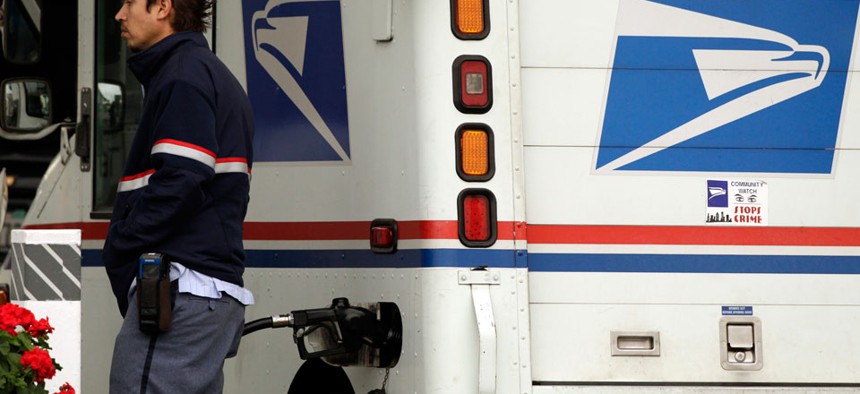Commentary: Can Driverless Cars Save the Postal Service?

Current postal vehicles require drivers. Damian Dovarganes/AP file photo
Autonomous vehicles are coming to streets near you sooner than you think.
Ding! That sound could soon be the USPS app alerting you to an imminent delivery, after which a driverless Postal Service vehicle arrives at your door and a robotic arm delivers your package.
While this may sound like science fiction, driverless vehicles will be coming to streets near you sooner than you may think. Sixteen states already have introduced driverless vehicle legislation and California, Nevada, Florida, and the District of Columbia have enacted laws allowing driverless vehicles on their roads. Sergey Brin, co-founder of Google and a driverless vehicle advocate, forecasts fully autonomous vehicles will be available for sale in five years.
Driverless vehicles have the potential to transform many enterprises focused on transporting goods. The Postal Service’s fleet of 215,000 vehicles traveled over 1.3 billion miles in 2012, roughly equivalent to circumnavigating the globe 172 times every business day. Driverless vehicles could reduce operating costs through increased safety, fuel efficiency, and new business models. After posting a quarterly loss of $1.9 billion in May, it’s time for USPS to explore reinvention.
Think about what a day in the life of a USPS driverless vehicle might look like:
12:18 a.m. The latest software package with updated mapping information and the day’s optimized delivery route is downloaded directly from fleet headquarters.
12:30 a.m. The vehicle begins delivery on its suburban route -- the pre-determined optimal time for mail delivery on that particular day.
5:00 a.m. A local bakery’s two-hour reservation through USPS’s CloudCar program begins and the vehicle delivers bread to grocers around town. Since the bakery owner no longer has to maintain his own fleet of delivery trucks, he can hire two more bakers and double production.
7:22 a.m. The vehicle stops at a full service gas station, refuels and reports a maintenance diagnostic assessment to fleet headquarters, allowing USPS to forecast maintenance requirements and plan accordingly.
11:13 a.m. After completing initial deliveries, the car is identified as available. Just then, a business executive pulls up the USPS mobile app on her phone, checks-in at her current location and orders a rush delivery of a time sensitive document.
3:15 p.m. While en route, the car’s sensors detect a large pothole, triggering an automatic report to the local transportation department with geotagged images of the hazard.
4:18 p.m. A businessman suddenly remembers that today is his anniversary. He places an order at a local florist, who has an urgent delivery contract with USPS’s new dynamic pricing system. The vehicle stops at the florist and is then routed to the spouse’s residence.
7:14 p.m. After completing its custom delivery orders and returning to the USPS regional warehouse, the vehicle sends its daily diagnostic report to fleet headquarters, and begins the next round of deliveries.
While this is only a thought experiment, the potential for new operating models and cost savings is very real.
Removing the driver from a vehicle enables it to be used around-the-clock. Routes could be designed around optimal traffic patterns and delivery needs. Driverless vehicles also could be used as a shared service with other businesses and government agencies leasing time when the vehicles are available, similar to the Uber Taxi model. With its significant vehicle fleet and 42,000 ZIP code reach, the Postal Service is well positioned to pilot new service models. It could, for instance, coordinate with auto manufacturers and the State of California to test the readiness of its highways for driverless cars.
Driverless vehicles also have the potential to reduce vehicle operating costs. In 2012, Google reported that after driving 300,000 miles, its driverless cars were not involved in any accidents. Computer control of cars mitigates against human error, such as fatigue or distraction, leading to greater safety. Vehicle accidents and wear-and-tear create significant operating costs for large enterprises like USPS. In FY 2011 alone, USPS had over 20,000 motor vehicles accidents. According to OSHA, the average vehicle crash costs an employer $16,500. The average cost skyrockets to $74,000 when an employee has an on-the-job crash resulting in injury. With fewer vehicle-related accidents, USPS could see substantial cost savings.
As gas prices continue to climb, fuel is another major cost for large fleet operators. The Postal Service spent nearly $500 million in 2011 and required $614 million in maintenance. With an average vehicle age of 16 years, fuel and maintenance costs will continue to climb. A Columbia University study identified that “cars simply managing their own speed would increase efficiency by an appreciable 43 percent.” Further, the study estimated that once there are more driverless vehicles on the road that are able to platoon with each other, energy savings may jump to 273 percent.
Federal agencies have long promoted innovative technologies, from GPS to the Internet. As the largest purchaser of goods and services and operator of the largest vehicle fleet in the world, the federal government and USPS have the potential to usher in the driverless car revolution.
Samra Kasim is a Senior Consultant and GovLab Innovation Fellow at Deloitte Consulting LLP. Her research focuses on the intersection of policy and technology. She can be reached at: skasim@deloitte.com
Matt Caccavale is a Senior Consultant and GovLab Innovation Fellow at Deloitte & Touche LLP. He specializes in security and privacy for public-sector clients. He can be reached at: macaccavale@deloitte.com
NEXT STORY: White House Promises Open Government 2.0


